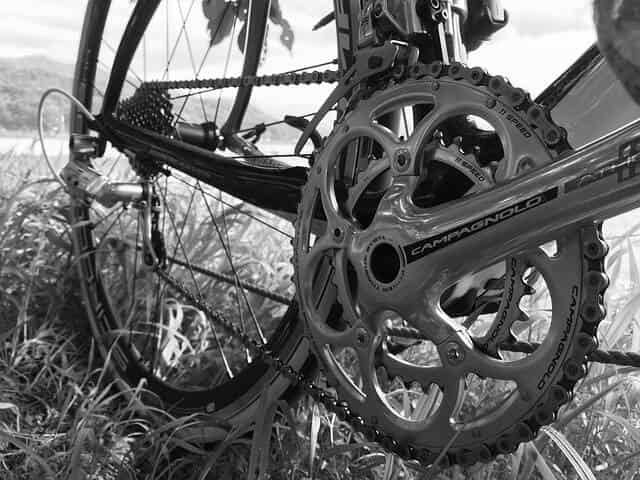Every cyclist should have different bike tools required to fix your tires or when repairing chains, but not always. Luckily there is a way you can remove and repair the bike chain without any special tool.
Bikes are incredible feats of engineering. They seem simple, and yet they are the most energy-efficient mode of transportation we have created.
The bicycle can turn as much as 90% of the energy you use when pedaling into kinetic energy.
The chain is integral to this process. Without it, you’d just be spinning the cranks, working up a sweat, but getting nowhere. So, it’s important that you take care of your chain, even if it requires removing it entirely.
You’ve probably heard of chain pin pliers and chain breakers, tools made to service chains. But, don’t think that you absolutely need those tools to do the job.
There are other ways to get those links off, using common tools, household objects, or your bare hands.
Moreover, bike chain manufacturers have engineered special links to increase the ease of chain removal and repair. Called “master” links, these innovative components offer more convenient service options for those of us who don’t have every tool and don’t want to take a trip to the bike repair shop.
I want to make things more convenient for you too, so I’ve gathered all this information together in one place. We’ll start by looking at the master link in general, and how it can easily be removed without a special tool or simply with items you likely have on hand.
Removing the Master Link Without a Special Tool
Follow these simple steps to remove your most common style of master link:
- Position your bike. Flip your bike upside down, so it is supported by the seat and handlebars, with the drivetrain facing you.
- Put the chain in the lowest gear. You want to have slack to work with.
- Clean your chain! If your chain is covered in mud, dirt, and grime, it will be harder to locate the master link, and more difficult to remove it.
- Find the master link. Turn the pedal to rotate the chain until you see a link that looks different from the rest. Master links are often a different color than the rest of the chain, to make this process easier. I will go over this in detail in the next section.
- Press the pins on the master link inwards towards one another. There are few ways to do this without a specialized tool:
- Use a pair of pliers. Position the jaws of the pliers around the two pins in the master link, and squeeze so that the pins are pulled towards the center.
- Use a cord or a shoestring. You can take a sturdy cord and slip one end through the chain on either side of the master link. Cross the ends and pull them so that they tighten around the link, and pull the pins inward. You may have to pull hard, but this method works.
How To Find Master Rivet on Bike Chain
Finding the master link on your chain can be difficult. Some stand out from the rest of the chain more than others. The longer the link remains on the chain, the more it takes on the same qualities of wear as the other links. And, if the chain is dirty or, worse, rusted, the distinguishing features may be obscured.
That’s why the first step in finding the master link is to clean your chain. Take a microfiber cloth and wipe away all the accumulated dirt. If that’s not enough, use a degreaser and really strip everything away. Just make sure to apply chain lube again afterward.
Once the chain is clean, you can inspect the links. Master links have a few telltale signs that give them away:
Different color shade. Many master links are manufactured to be a lighter shade than the other links, or a different color altogether.
Tapered slots around the pin. Every other link has pins secured in place with no space around them. Most master links have tapered slots, with pins secured in the narrow end while under tension.
“C” Clip. This clip secures the two pins in the style of the master link that lacks the tapered holes. You won’t be able to miss this detail.
3 Common Types of Master Chain Link
Shimano Rivet Bike Link
As the name suggests, the Shimano rivet link system doesn’t actually use a master link. Instead, it uses special replacement pins, called joining or connecting pins, to allow you to safely reconnect a link in one of their chains. So, how does this work?
Well, a chain without a master link can only be fully removed if you extract one of the pins. No matter how you do this, the hole that the pin sits in is slightly enlarged in the process. This means that reconnecting the chain at the same point, with the same pin, will result in loose connection.
Shimano’s joining pins address this by being tapered at one end, and thicker in diameter. They actually widen the hole a bit further when being installed, but this creates a tight fit.
Additionally, the pin is segmented so that the tapered end can be snapped off, leaving the pin flush with the chain on both sides. This allows riders to repair their chain at any spot along its length. However, once installed, the joining pin itself can’t be reused or replaced with another joining pin.
SRAM Power Master Links
SRAM’s take on the master link, branded the PowerLink, is widely considered to be the easiest to remove. Yet, it was primarily designed to address a safety concern present in some pre existing varieties.
Many master links depend on chain tension to remain secure. It’s this tension that pulls the pins into the narrow end of their slot in the link plate. As you’ve read, reversing this pressure is how you remove the link.
However, a master link can become compressed under certain circumstances while riding, and disengage in that way. It’s not exactly common, and mostly occurs on older bikes with worn down sprockets, but it can happen.
SRAMs solution is to design the pins so that it takes more than just pressure along one axis to move them. The pins are thicker at the top than further down, and the holes they sit in are shaped so that they can’t move so long as the upper portion is slotted in.
You have to press down on the plates, or the link won’t budge. Once the thick upper portion is cleared, the plates move freely, and the link can easily be removed. This process can be performed without any tools. The downside is that a PowerLink can only be safely used once.
Clip “C” Style Master Links
I’ve mentioned this mysterious “C” clip several times already, and I know you’re wondering: “What is it?” This type of master link is different from others in a few key ways.
First, it has both pins riveted onto one plate. The other plate is smooth, with two holes fitted for those pins to pass through. The pins themselves have a groove etched around the top, and that is where the clip comes in.
The long clip has cut outs within the interior that fit into the grooves on the two pins. Once snapped into place, it holds the master link securely, without any concern for the tension on the chain.
This makes the clip incredibly reliable in hard riding conditions where chain tension can be extreme and unpredictable. However, the clip adds extra bulk to the link’s profile, making it unsuitable for use on bikes with more than 9-10 gears, which require thinner chains.
That said, you’ll often hear mountain bikers who opt for a “C” clip for demanding rides. Some single speeds and other bikes with more accomodating drivetrains also feature this link.

How To Remove Shimano Master Chain Rivets
Removing a rivet from a Shimano style chain is essentially no different from removing the pin from any chain without a master link. There is a tool for the job called a chain breaker, which works just as well for both types.
To do it with the chain breaker tool, clean your chain and position your bike as instructed in the earlier step by step list. From there, follow these steps:
- Choose the rivet you will remove. While you can pick any one you want, it’s best to pick one on the leading end of a link. This means the pin of the two on a link that is furthest in the direction that the chain is being pulled while pedaling.
- Position the link in the chain breaker. The tool has a guide that is essentially a block with a channel carved into it for the rivet. Align the rivet with that channel.
- Tighten the pin driver against the pin. The pin driver is controlled by a screw handle. As you turn the handle, the driver extends towards the link. Do this until the link is held in place by the driver.
- Make sure the driver is centered on the pin, and the pin is centered on the guide channel.
- Screw the pin driver to push the rivet out of place. Use a slow, steady pace, turning the handle to slide the pin completely out of the link.
Doing this without the tool is fairly difficult. You can use a hammer and nail to drive the pin out, but this requires you to lay your bike on its side, and to position the link over different types of guide — a piece of wood with a correctly sized hole drilled into it works well. Center the rivet over that guide, and tap it out carefully using the nail as the driver.
How To Remove SRAM Master Link on Mountain Bikes
To remove an SRAM, once again you should follow steps 1-4 from the first guide. Then, take the following easy steps:
Grip the link between thumb and forefinger. Hold it so your fingers are on the plates on either side.
Squeeze the plates to depress them down the pins. Do this until you see the slimmer lower portion of the stepped pins.
Slide the plates in opposite directions. While holding them down, slide the plates so that the pins are within the larger part of their groove. This will allow you to remove the plates and the link itself.
As you can see, no tools are usually needed to deal with an SRAM master link. However, dirt, rust, or other factors can make it harder to pop the link off. If you have trouble, use a pair of pliers to squeeze the pins as described in the first guide, while also squeezing the plates down.
An alternative method involves arranging the master link in a particular orientation that applies a diagonal pressure to the pins and plates. It works like this:
Arrange the link in a “Z” shape. This involves 3 links: the master link, and the link on either side of it. Hold the chain so that the master link is positioned vertically, while the two links at either end of it are horizontal.
Then, move the horizontal links towards the master link. This will cause the SRAM link to swivel into a diagonal orientation between the other two links, the “Z” shape.
Squeeze down on the “Z.” Grip it at the top and bottom and apply pressure.
Pull the chain outward. While squeezing down on the “Z” section, pull the chain ends on either side of it. This requires a bit of dexterity, but it’s another way to remove this link without a tool.
How to Remove a “C” Style Master Link
Unlike the SRAM master link, the “C” style link can’t be removed without any tools at all. Yet, all you need is a flat head screwdriver, or anything similar, to quickly and easily remove this master link. Begin by following steps 1-4 from the first guide.
Cleaning is particularly important because enough grime buildup may obscure the clip, making the link hard to locate. Once you’ve found it, take the following steps:
- Place the head of the screwdriver between the prongs of the clip. The screwdriver should be perpendicular to the surface of the link, and closer to the open end of the clip.
- Spread the prongs by turning the screwdriver. As you turn the head, it will cause the prongs to flex outward, releasing their grip on the pins. Only open the clip enough to disengage it.
- Remove the clip. While it’s spread, it’s a simple matter to pull the clip away from the link. You can do it by tilting the screwdriver, or just use your other hand.
- Remove the outward facing plate. This is the plate that was under the clip, and it comes off easily once the clip is removed. At that point, you can take the link out of the chain entirely.
Removing a Chain Link Without a Special Tool
Not every bike chain has a master link. Those that don’t are the most secure, as every link is equally well secured. This does mean they aren’t as convenient to remove and service, but it can be done.
If you recall, Shimano chains also lack a master link, and removing a regular chain link follows the same basic process of removing a so-called master rivet, though it needs to be done twice to remove an entire link.
Once again, it’s necessary to resort to a hammer and nail if you don’t have the chain breaker tool. I say nail, but it would be best to use a slim metal piece with an end that is flat instead of pointed.
Follow the same procedure detailed in the Shimano guide, but do it for both pins in the link to remove it entirely. This is something that you’ll do if you need to shorten the chain, or want to swap a regular link for a master link.
If you don’t need to remove the entire link, then only disconnect a single pin — and don’t remove that pin entirely. Remember, removing the pin widens the opening it was in. If you leave it in one plate, it will maintain greater integrity and can be reused.
Putting the Chain Back On
Once a link is uncoupled, you can remove the chain from your bike entirely. Maybe you needed to clean it thoroughly, or maybe you’re installing a new chain.
In any case, putting it back on requires paying careful attention to detail. The process isn’t bad for single speed bikes. You would simply set the reconnected chain onto the rear sprocket, and as much of the chain wheel as you can, then turn the pedals and the chain will be pulled into place.
The chain reconnection process differs a little for each master link, but the basic process involves the following:
- Slide the pins into the holes of the corresponding inner links. Keep the branded side of the link facing outward for proper orientation.
- Pull the chain taut. This sets the pins in the narrow part of the tapered groove that holds them and will work for SRAM style master links.
- “C” clips require you to snap the clip into place. You don’t need to pull the chain to secure these, but make sure the open part of the clip is facing the direction in which the chain is being pulled.
If there is no master link present, then you’ll need to install a new link, reversing the Shimano rivet removal process as described above.
For bikes with rear derailleurs, you will need to route the chain through the mechanism first.
Take the end of the chain with no pin present, and bring it over the lower pulley sprocket, then up around the top pulley sprocket, in an “S” shape.
Continue by fitting the chain over the smallest sprocket in the rear cassette. Route the chain through the front derailleur. Wrap it around the smallest front chain wheel.
Connect the chain, using one of the previously outlined methods.
Conclusion
The truth is, it’s always going to be easier to work with your chain if you use the tools specially made for the job. Other methods can and do work, often without issue. However, chain links can be more delicate than you’d expect, and making a mistake with improvised methods can ruin them.
That said, sometimes you will find yourself in a position where you need to service your chain and the proper tools simply aren’t on hand.
Being able to install a chain and connect it can make the difference between riding and walking home. Hopefully, this guide has given you the confidence you need to rise to such an occasion.
Also Read,
How To Make Bike Brake More Responsive? Adjust Bike Brakes Easy









Thank you for sharing this